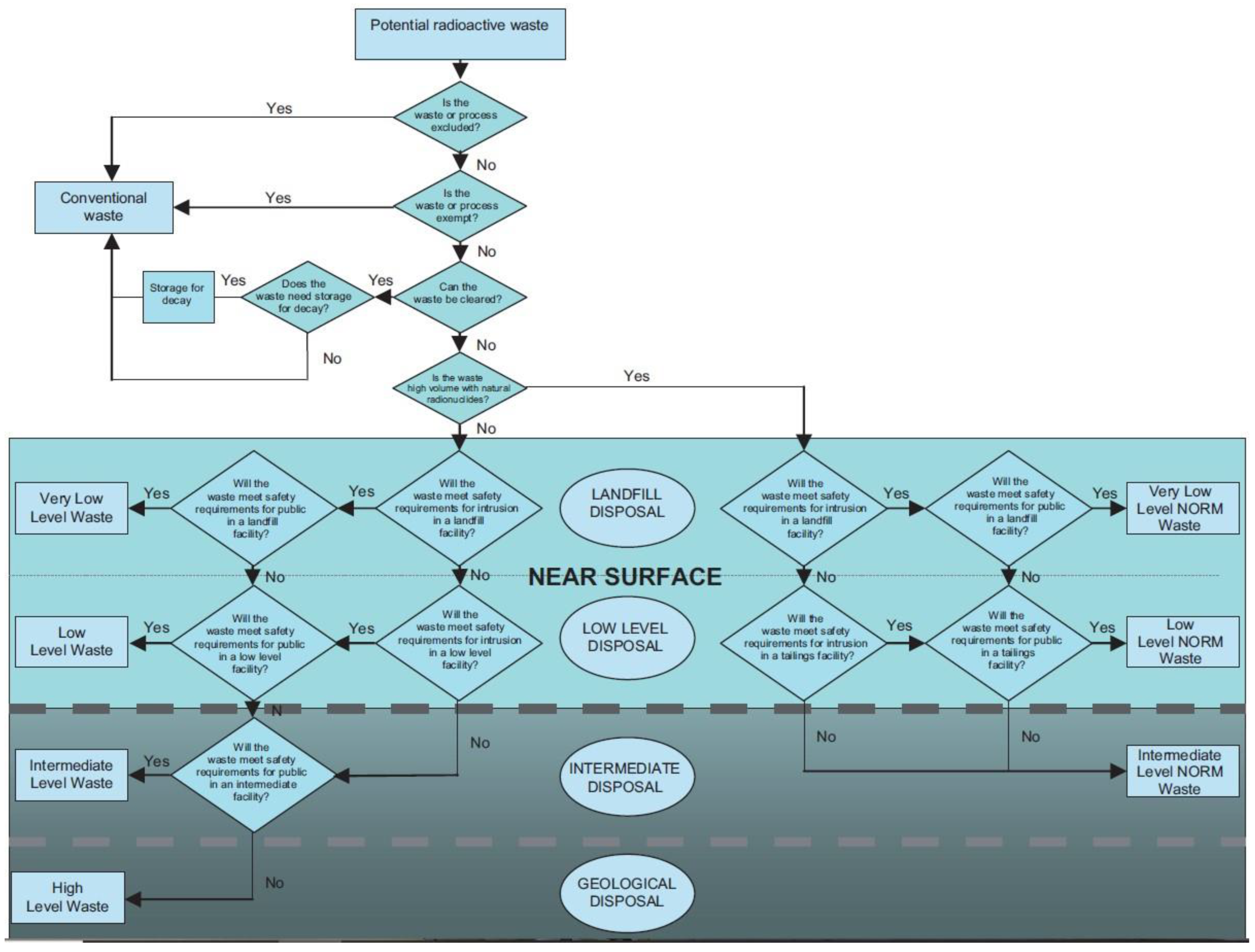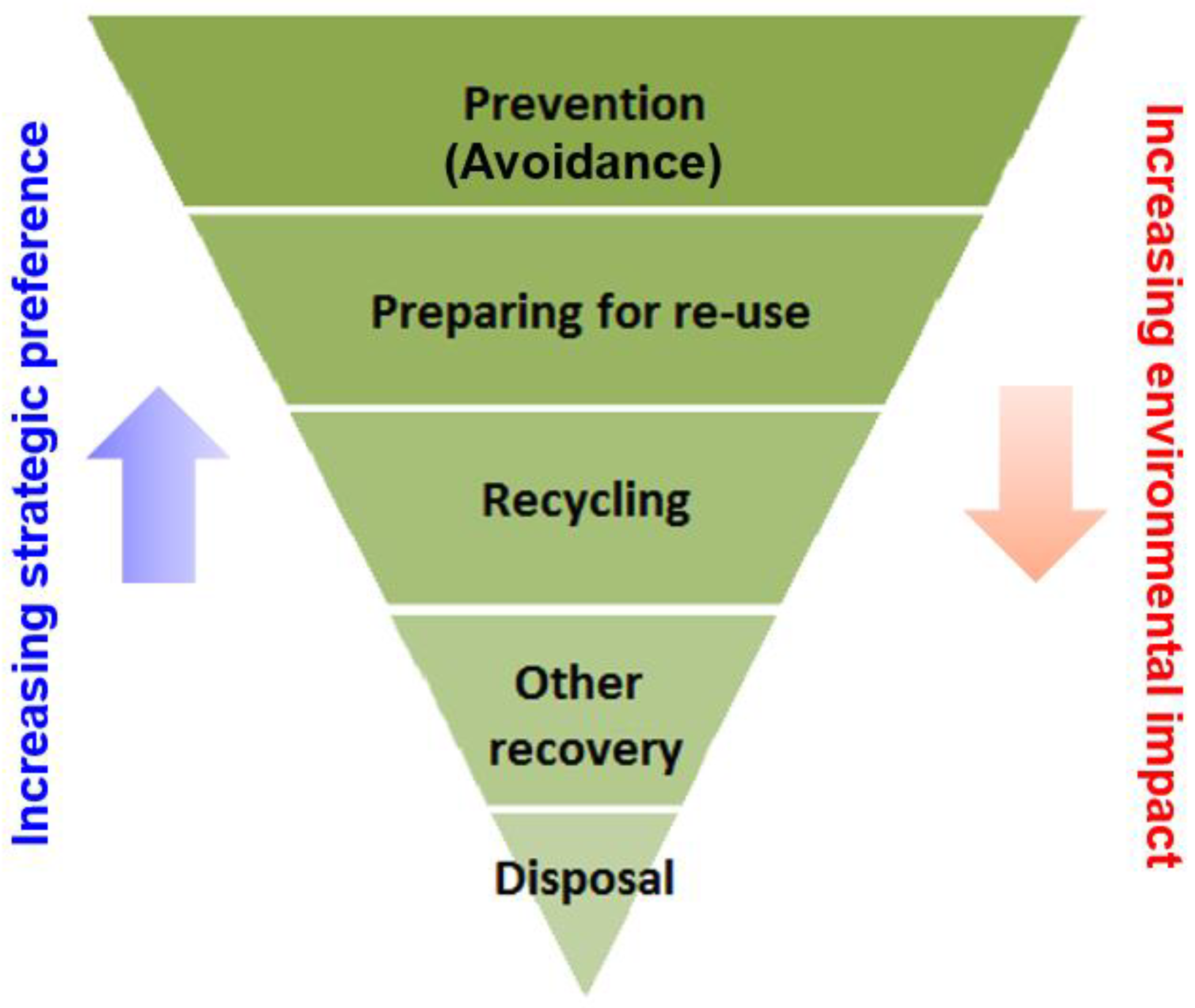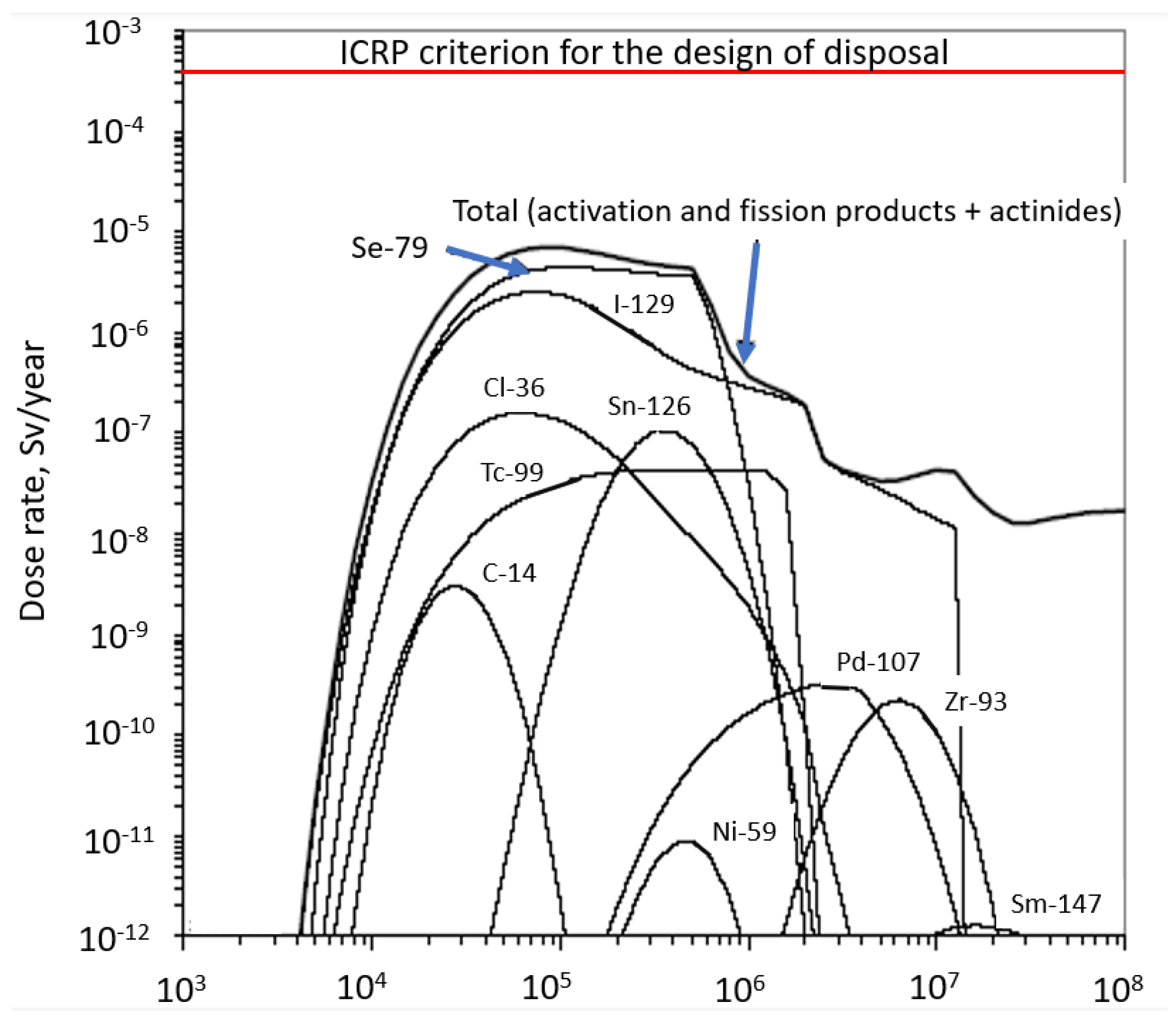Nuclear Waste Disposal
Definition
:1. Introduction
2. Nuclear Waste Lifecycle
- Pretreatment. The first step includes all operations carried out with waste prior to treatment i.e., waste collection, segregation, chemical adjustment, and decontamination. It aims to facilitate the selection and further use of waste processing technologies.
- Treatment. The second step comprises all operations which improve both the safety and the economy of NWM, by changing the characteristics of nuclear waste. Its objectives are to: (i) reduce the waste volume, e.g., by using compaction; (ii) remove the radionuclides from the waste, e.g., by purifying contaminated waters; and (iii) change the waste composition, e.g., by transforming the initial (raw) burnable waste into non-burnable oxide form, represented by incineration residues and ashes. It is notable that treatment may result in a wasteform that is suitable for safe handling and conditioning, e.g., plasma treatment can result in a solid and durable glass crystalline material.
- Conditioning. This step results in waste packages which are suitable for further safe handling, transportation, storage, and/or disposal. It is typically accomplished by enclosing the waste in containers and providing overpacks when needed. Although not always necessary, this stage may include the conversion of the raw liquid or dispersed waste materials into a solid monolithic wasteform via immobilization i.e., using solidification, embedding, or encapsulation.
- Storage. This step provides confinement, isolation, environmental protection, and monitoring of nuclear waste, in a dedicated storage facility, for certain periods of time (storage periods), ensuring its retrievability.
- Transportation. This step refers to the deliberate physical movement of nuclear waste in a dedicated manner, i.e., a manner specifically designed for the safe transportation of packages from one place to another.
- Disposal. This step is the end point of NWM, and envisages the emplacement of nuclear waste in an appropriate disposal facility, without the intention of retrieval.
3. Nuclear Waste Classification
- Short-lived;
- Long-lived.
- Very short-lived waste (VSLW). This is nuclear waste that can be stored for natural decay of waste radionuclides over a sensible short period, which is typically a few months, but no longer than one to a maximum of a few years. Thereafter, the nuclear waste can be cleared from regulatory control, because of the very low (below exemption levels [3]) content of radionuclides. VSLW typically results from uses of nuclear energy in medicine (mainly in medical diagnostic procedures), although also from research activities, and sometimes within education and training exercises;
- Very low-level waste (VLLW). This is nuclear waste which contains radionuclides at levels which are not significantly above clearance levels. Typically, the activity concentration in this waste does not exceed 100 times the clearance levels for each of the waste radionuclides. Therefore, this waste does not require a high level of containment and isolation, from the point of view of its potential as a hazard. Taking that into account, VLLW can be disposed of in near-surface landfill-type facilities with rather limited regulatory control. VLLW typically presents in the form of soil and rubble, and is often disposed of in purpose-built disposal facilities such as earthen trenches;
- Low-level waste (LLW). LLW is nuclear waste with radionuclide contents significantly above clearance levels, however containing only limited amounts of long-lived radionuclides. As such, LLW requires robust isolation and containment in near-surface disposal facilities (NSDF) [14], for periods of up to a few 100 years, before natural decay of waste radionuclides below exemption levels. LLW is typically the largest by-volume nuclear waste stream arising from utilization of nuclear energy in power generation (by nuclear power plants), medicine, industry, and research. LLW is most often disposed of in engineered NSDFs, which may be either sophisticated or simple by design, and include engineered trenches and concrete vaults where nuclear waste containers are placed. Another disposal option for LLW is the use of sub-surface disposal facilities;
- Intermediate-level waste (ILW). This is nuclear waste which contains significant levels of both short- and long-lived radionuclides, although it does not need any provision for radiogenic heat dissipation. Because of the high content of long-lived radionuclides, ILW requires a greater degree of containment and isolation compared with LLW. The disposal depths required for ILW are of the order of several tens to a few hundred metres [14] although co-disposal of ILW with SNF and high-level waste is an effective option as well [15]. A precise boundary between LLW and ILW is not prescribed by the IAEA, although for long-lived radionuclides, it does recommend a limit average content of 400 Bq/g, and up to 4000 Bq/g for any individual package [13]. The required limiting levels cannot be generic, as they result in each specific case from the safety analysis reports, and are thus specific to the given disposal site and facility;
- High-level waste (HLW). This is nuclear waste with levels of activity concentrations high enough to require shielding from the radiation emitted by decaying radionuclides, and which also generate enough high quantities of radiogenic heat through the radionuclide decays. The heat generation levels above which provisions for heat dissipation are needed are usually above a few W/m3 at a typical volume of ~1 m3, although they depend on the sizes and volumes of waste items. HLW includes nuclear waste with a higher content of long-lived radionuclides, which implies it must be accounted for in the designs of the disposal facilities. Geological disposal facilities (GDF), located in deep, stable, geological formations which are located at least several hundred meters from the Earth’s surface, are the generally recognised disposal option for HLW [15]. This is because HLW requires a disposal end point in which it will be isolated for geological timescales of the order of hundreds of thousands, or even millions, of years [5,15,16,17,18,19,20,21]. Stable and geochemically and geo-physically suitable geological formations can provide adequate conditions, aiming to safely confine and isolate the HLW in the GDFs, from the population and the habitation environment. GDFs can thus protect HLW from the dangers that may result from eventual future changes on the surface of the Earth, including climate or unforeseen societal activities.
4. Nuclear Waste Disposal Practices
5. Safety of Disposal
- limit the exposure doses (typically given in mSv/y) or risks (relative to other risks);
- achieve levels of radiological protection for future generations that are the same (not less) as those currently achieved;
- ensure that the additive impact of the disposal system on the natural radiation background, is limited.
6. Conclusions
Funding
Institutional Review Board Statement
Data Availability Statement
Conflicts of Interest
References
- IAEA. Nuclear Safety and Security Glossary; IAEA: Vienna, Austria, 2022. [Google Scholar]
- IAEA. PRIS, Power Reactors Information System. Available online: https://pris.iaea.org/pris/home.aspx (accessed on 4 January 2023).
- IAEA. Radiation Protection and Safety of Radiation Sources: International Basic Safety Standards; Safety Standards Series GSR Part 3; IAEA: Vienna, Austria, 2014. [Google Scholar]
- IAEA. Selection of Technical Solutions for the Management of Radioactive Waste; TECDOC-1817; IAEA: Vienna, Austria, 2017. [Google Scholar]
- Ojovan, M.I.; Lee, W.E.; Kalmykov, S.N. An Introduction to Nuclear Waste Immobilisation, 3rd ed.; Elsevier: Amsterdam, The Netherlands, 2019; 497p. [Google Scholar]
- Chapman, N.; Hooper, A. The disposal of radioactive wastes underground. Proc. Geol. Assoc. 2012, 123, 46–63. [Google Scholar] [CrossRef]
- Yudintsev, S.V.; Nickolsky, M.S.; Ojovan, M.I.; Stefanovsky, O.I.; Nikonov, B.S.; Ulanova, A.S. Zirconolite Polytypes and Murataite Polysomes in Matrices for the REE—Actinide Fraction of HLW. Materials 2022, 15, 6091. [Google Scholar] [CrossRef]
- IAEA. Policies and Strategies for Radioactive Waste Management; IAEA Nuclear Energy Series, NW-G-1.1; IAEA: Vienna, Austria, 2009; 68p, Available online: http://www.pub.iaea.org/MTCD/publications/PDF/Pub1396_web.pdf (accessed on 4 January 2023).
- Pershukov, V.; Artisyuk, V.; Kashirsky, A. Paving the Way to Green Status for Nuclear Power. Sustainability 2022, 14, 9339. [Google Scholar] [CrossRef]
- Drace, Z.; Ojovan, M.I.; Samanta, S.K. Challenges in Planning of Integrated Nuclear Waste Management. Sustainability 2022, 14, 14204. [Google Scholar] [CrossRef]
- Yang, J.; Wang, J.; Zhang, X.; Shen, C.; Shao, Z. How Social Impressions Affect Public Acceptance of Nuclear Energy: A Case Study in China. Sustainability 2022, 14, 11190. [Google Scholar] [CrossRef]
- IAEA. Fundamental Safety Principles; IAEA Safety Standards Series No. SF-1; IAEA: Vienna, Austria, 2006. [Google Scholar]
- IAEA. Classification of Radioactive Waste; General Safety Guide GSG-1; IAEA: Vienna, Austria, 2009. [Google Scholar]
- IAEA. Scientific and Technical Basis for Near-surface Disposal of Low and Intermediate Level Waste; TRS-412; IAEA: Vienna, Austria, 2003. [Google Scholar]
- IAEA. Scientific and Technical Basis for Geological Disposal of Radioactive Wastes; TRS-413; IAEA: Vienna, Austria, 2003. [Google Scholar]
- Chapman, N.A.; McKinley, I.G. The Geological Disposal of Radioactive Waste; John Wiley and Sons: New York, NY, USA, 1987. [Google Scholar]
- Chapman, N.; McCombie, C. Principles and Standards for the Disposal of Long-Lived Radioactive Wastes; Elsevier: Amsterdam, The Netherlands, 2003; 250p. [Google Scholar]
- Ahn, J.; Apted, M.J. Geological Repository Systems for Safe Disposal of Spent Nuclear Fuels and Radioactive Waste, 2nd ed.; Elsevier: Cambridge, UK, 2017; 778p. [Google Scholar]
- Rohlig, K.-J. Disposal and other conceivable strategy ‘endpoints’ for different types of waste. In Nuclear Waste: Management, Disposal and Governance; Rohlig, K.-J., Ed.; IOP Publishing, Ltd.: Bristol, UK, 2022; Chapter 7; pp. 7.1–7.19. [Google Scholar] [CrossRef]
- Rohlig, K.-J. Geologic (‘deep’) disposal of high-level and other long-lived waste: Host rocks, concepts, current international status. In Nuclear Waste: Management, Disposal and Governance; IOP Publishing, Ltd.: Bristol, UK, 2022; Chapter 8; pp. 8.1–8.25. [Google Scholar] [CrossRef]
- Ojovan, M.I.; Steinmetz, H.J. Approaches to Disposal of Nuclear Waste. Energies 2022, 15, 7804. [Google Scholar] [CrossRef]
- National Academies of Sciences, Engineering, and Medicine. Merits and Viability of Different Nuclear Fuel Cycles and Technology Options and the Waste Aspects of Advanced Nuclear Reactors; The National Academies Press: Washington, DC, USA, 2022. [Google Scholar] [CrossRef]
- IAEA. International Low Level Waste Disposal Network—DISPONET. Available online: https://nucleus.iaea.org/sites/connect-members/DISPONET/SitePages/Home.aspx (accessed on 16 March 2023).
- IAEA. Underground Research Facilities Network for Geological Disposal (URF Network). Available online: https://nucleus.iaea.org/sites/connect-members/URF/SitePages/Home.aspx (accessed on 16 March 2023).
- IAEA. International Predisposal Network (IPN). Available online: https://nucleus.iaea.org/sites/connect-members/IPN/SitePages/Home.aspx (accessed on 16 March 2023).
- IAEA. Costing Methods and Funding Schemes for Radioactive Waste Disposal Programmes; IAEA Nuclear Energy Series No. NW-T-1.25; IAEA: Vienna, Austria, 2020; 90p. [Google Scholar]
- IAEA. Design Principles and Approaches for Radioactive Waste Repositories; NW-T-1.27; IAEA: Vienna, Austria, 2020. [Google Scholar]
- IAEA. Disposal of Radioactive Waste; Specific Safety Requirements No. SSR-5; IAEA: Vienna, Austria, 2011. [Google Scholar]
- ICRP. Radiological Protection Policy for the Disposal of Radioactive Waste; Publication 77; Pergamon Press: Oxford, UK; New York, NY, USA, 1997. [Google Scholar]
- IAEA. Approach to the Development of Waste Acceptance Criteria for Low and Intermediate Level Waste; IAEA: Vienna, Austria, 2023; in press; Unpublished Technical Report. [Google Scholar]
- IAEA. The Safety Case and Safety Assessment for the Disposal of Radioactive Waste; Safety Standards Series No. SSG-23; IAEA: Vienna, Austria, 2012. [Google Scholar]
- Final Disposal Posiva. Available online: https://www.posiva.fi/en/index/finaldisposal.html (accessed on 30 January 2023).
- WNN, World Nuclear News. Available online: https://www.world-nuclear-news.org/Articles/Swedish-government-gives-go-ahead-for-used-fuel-re (accessed on 30 January 2023).
- Gibb, F.G.F.; Beswick, A.J. A deep borehole disposal solution for the UK’s high-level radioactive waste. Proc. Inst. Civ. Eng.–Energy 2022, 175, 11–29. [Google Scholar] [CrossRef]
- Finsterle, S.; Muller, R.A.; Grimsich, J.; Bates, E.A.; Midgley, J. Post-Closure Safety Analysis of Nuclear Waste Disposal in Deep Vertical Boreholes. Energies 2021, 14, 6356. [Google Scholar] [CrossRef]
- Mallants, D.; Sander, R.; Avijegon, A.; Engelhardt, H.-J. Cost Analysis of Deep Large-diameter Drill Holes–21048. In Proceedings of the WM2021 Conference, Phoenix, AZ, USA, 8–12 March 2021. [Google Scholar]
- Kochkin, B.; Malkovsky, V.; Yudintsev, S.; Petrov, V.; Ojovan, M. Problems and perspectives of borehole disposal of radioactive waste. Prog. Nucl. Energy 2021, 139, 103867. [Google Scholar] [CrossRef]
- IAEA. Nuclear Technology Review; IAEA: Vienna, Austria, 2015. [Google Scholar]
- ICRP. Radiological Protection in Geological Disposal of Long-Lived Solid Radioactive Waste; ICRP Publication 122. Ann. ICRP 42 (3); ICRP: Ottawa, ON, Canada, 2013. [Google Scholar]



| Nuclear Waste Stream | End Point | ||||||
|---|---|---|---|---|---|---|---|
| Decay Storage | Surface Trench NSDF | Engineered NSDF | IDF | GDF (Deep) | Borehole | ||
| VSLW | Low volume | O | A | A | PTE | P | NTE |
| High volume | O | A | P | PTE | P | NTE | |
| VLLW | Low volume | NS | O | A | PTE | NTE | NTE |
| High volume | NS | O | A | PTE | NTE | NTE | |
| LLW | Low volume | NS | A | O | O | A | NTE |
| High volume | NS | PTE | O | O | A | NTE | |
| ILW | Low volume | NS | NS | NS | O | O | NTE |
| High volume | NS | NS | NS | O | O | NTE | |
| HLW and SNFW | NS | NS | NS | NS | O | O | |
| DSRS | Short-lived | A | A | O | A | PTE | O |
| Long-lived | NS | NS | A | O | O | O | |
| NORMW | Low volume | NS | O | A | A | PTE | NTE |
| High volume | NS | O | PTE | PTE | PTE | NTE | |
| Facility Type | Facility | Nuclear Waste 1 | Country |
|---|---|---|---|
| NSDF, trench | CIRES, Morvilliers | VLLW | France |
| NSDF, trench | El Cabril | VLLW | Spain |
| NSDF, engineered | CSA, De l’Aube | Short-lived LILW | France |
| NSDF, engineered | CSM, La Hague | Short-lived LILW | France |
| NSDF, engineered | Dukovany | LLW from NPPs | Czech Republic |
| NSDF, engineered | National Radioactive Waste Repository Mochovce | Solid and solidified low-activity waste from the operation and decommissioning of NPPs, research institutes, laboratories, and hospitals | Slovakia |
| NSDF, engineered | El Cabril Disposal Facility | LLW and ILW from hospitals, research centers, industries, and NPPs | Spain |
| NSDF, engineered | Low-Level Waste Repository, Drigg, Cumbria | LLW from a range of customers, such as the nuclear industry, the Ministry of Defence, non-nuclear industries, educational, medical, and research establishments | UK |
| Former limestone mine, access via horizontal drifts | Richard repository, Litoměřice | Institutional waste from healthcare, industrial, agricultural, and research sectors | Czech Republic |
| Former uranium mine, access via horizontal drifts | National Repository for LILW—Baiţa-Bihor | LILW | Romania |
| Intermediate depth, tunnels | Loviisa VLJ repository | LILW generated at the Loviisa NPP | Finland |
| Intermediate depth, silos | Olkiluoto VLJ repository | LILW generated in state-run industry, medical care, and research; in the future also waste from the Olkiluoto NPP | Finland |
| Intermediate depth, vaults and silos | SFR Forsmark | LILW from the operations of Swedish NPPs but also from hospitals, veterinary medicine, research, and industry | Sweden |
| Intermediate depth, boreholes | Planned | Disused sealed radioactive sources (DSRSs) | Ghana, Philippines, Malaysia, Brazil |
| GDF | Waste Isolation Pilot Plant (WIPP, Carlsbad, New Mexico) | Transuranic nuclear waste (clothing, tools, rags, residues, debris, soil, and other items contaminated with small amounts of Pu and other man-made radioactive elements), categorized as ‘contact-handled’ or ‘remote-handled’, on the basis of dose rate measured at the surface of containers | US |
| GDF | Asse II (abandoned salt mine, nuclear waste intended for retrieval) | Waste with negligible heat generation | Germany |
| GDF | ERAM (Morsleben) (former salt mine, facility to be closed) | Waste with negligible heat generation | Germany |
| GDF | Konrad (former iron mine, under construction) | Waste with negligible heat generation | Germany |
| GDF | Onkalo disposal facility (under construction [32] | SNF | Finland |
| GDF | Forsmark disposal facility (under construction [33]) | SNF | Sweden |
| GDF, deep boreholes | Under consideration [34,35,36,37] | HLW, SNF, DSRS | UK, US, Australia, Russia |
Disclaimer/Publisher’s Note: The statements, opinions and data contained in all publications are solely those of the individual author(s) and contributor(s) and not of MDPI and/or the editor(s). MDPI and/or the editor(s) disclaim responsibility for any injury to people or property resulting from any ideas, methods, instructions or products referred to in the content. |
© 2023 by the author. Licensee MDPI, Basel, Switzerland. This article is an open access article distributed under the terms and conditions of the Creative Commons Attribution (CC BY) license (https://creativecommons.org/licenses/by/4.0/).
Share and Cite
Ojovan, M.I. Nuclear Waste Disposal. Encyclopedia 2023, 3, 419-429. https://doi.org/10.3390/encyclopedia3020028
Ojovan MI. Nuclear Waste Disposal. Encyclopedia. 2023; 3(2):419-429. https://doi.org/10.3390/encyclopedia3020028
Chicago/Turabian StyleOjovan, Michael I. 2023. "Nuclear Waste Disposal" Encyclopedia 3, no. 2: 419-429. https://doi.org/10.3390/encyclopedia3020028
APA StyleOjovan, M. I. (2023). Nuclear Waste Disposal. Encyclopedia, 3(2), 419-429. https://doi.org/10.3390/encyclopedia3020028







